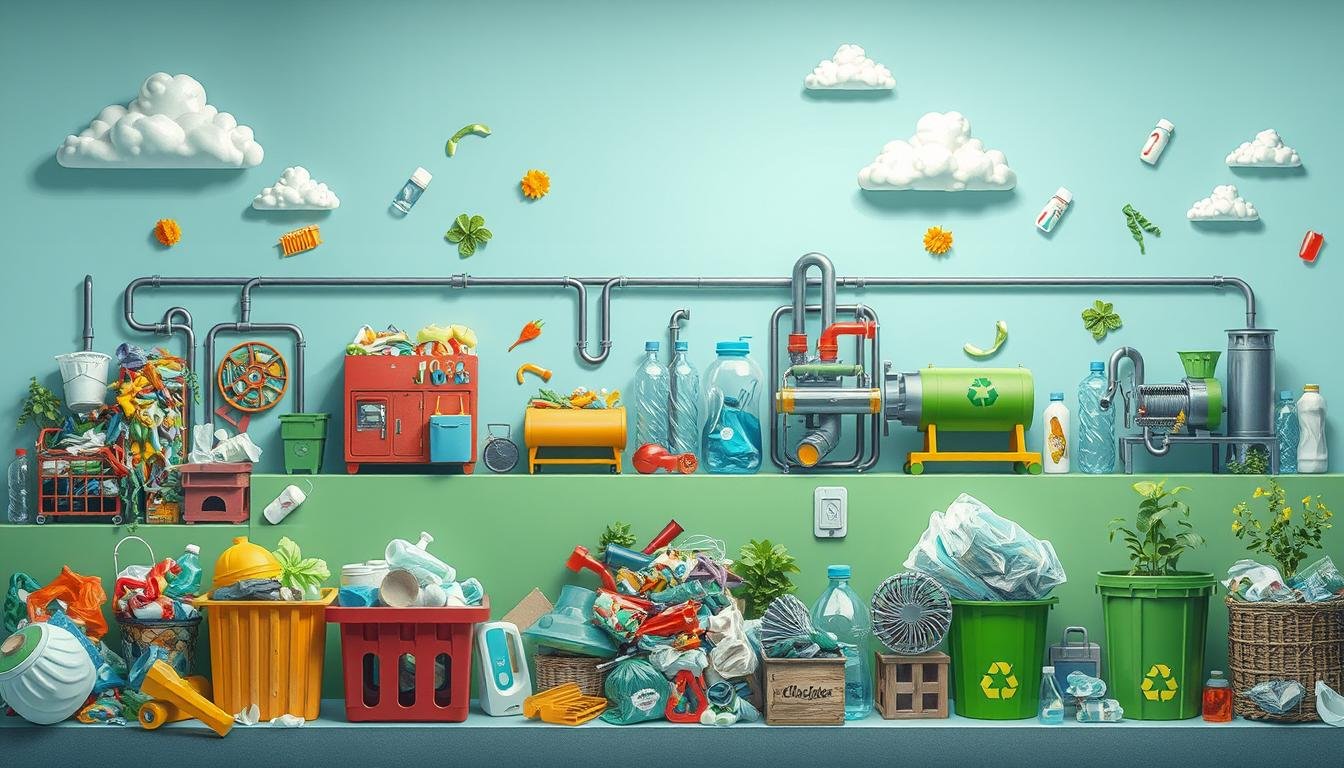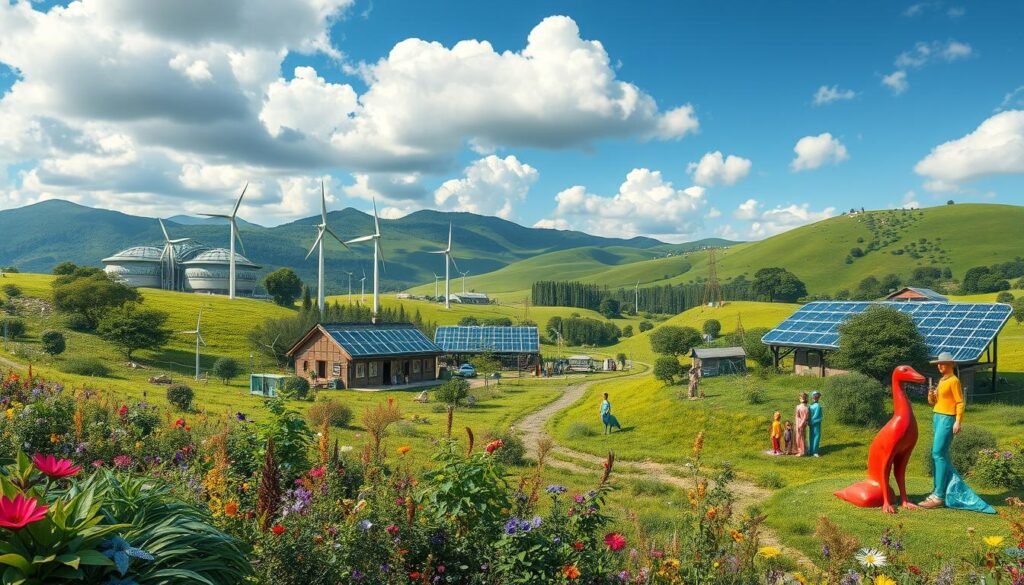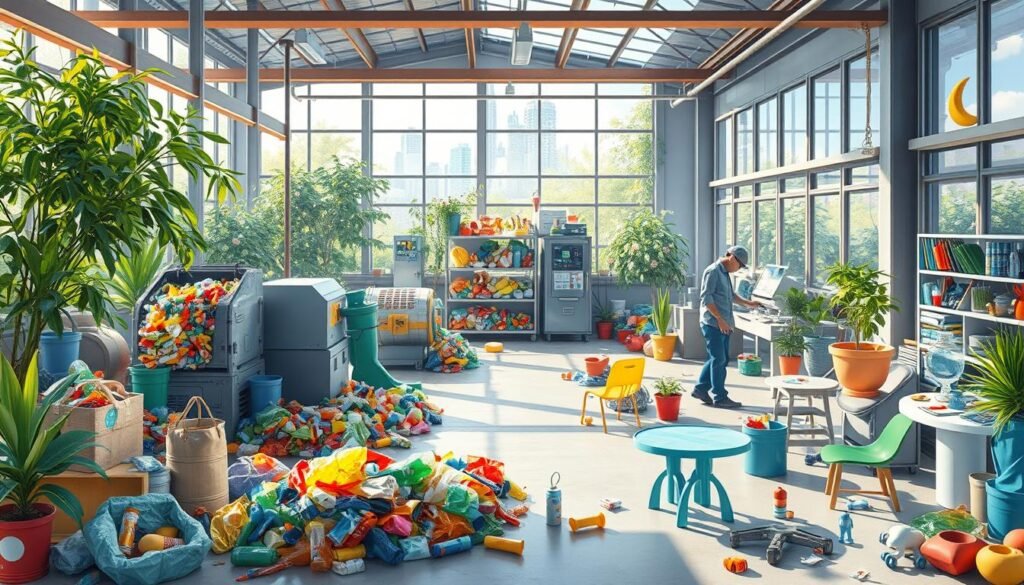Make some changes to the world environment
-
Building 3, Wanyang Innovation City, Langxia Street, Yuyao City, Zhejiang Province

What Happens To Plastic Recycling: The Complete Process
Have you ever wondered what happens to the plastic you carefully sort and place in the recycling bin? Despite our best efforts, only a small fraction of plastic waste truly gets recycled. Astonishingly, of the 8.3 billion metric tons of plastic produced over the past 70 years, only 9% has been recycled1. This journey of plastic recycling involves multiple intricate steps, each crucial to transforming waste into new, usable products.
By understanding the detailed plastic recycling steps, we can gain insight into the challenges and advancements in this vital process. Modern recycling methods have evolved significantly, offering substantial environmental benefits by reducing resource wastage and supporting sustainable practices.
Key Takeaways
- The plastic recycling process has six basic steps: collection, sorting, washing, shredding, identification, and compounding.
- Despite producing 230 million tonnes of waste annually, the UK only recycles a portion of it, highlighting room for improvement2.
- The recycling industry has created numerous jobs and additional revenue streams for businesses and governments3.
- Plastics like PET and HDPE are more widely recycled compared to others like PS due to cost and energy efficiency1.
- Modern technologies and public awareness are essential in enhancing the recycling process’s effectiveness.
- Recycling plastic helps preserve natural resources and mitigate environmental damage.
Introduction to Plastic Recycling
Plastic recycling has become an indispensable aspect of modern plastic waste management, driven by both environmental concerns and the need for sustainability. Modern recycling initiatives are refocusing consumer and industry efforts on the benefits of recycling to mitigate the extensive impact of plastic pollution.
From its introduction over a century ago, plastic has evolved into a ubiquitous material, creating a pressing need for effective recycling methods. The vast amount of plastic produced annually, which resulted in 450 million metric tons of greenhouse gases in 2021, underscores the urgency of recycling initiatives4. Approximately 44 million tons of plastic waste was generated in the United States in 2019, yet only five to six percent of plastics are recycled4.
The benefits of recycling are manifold, not only reducing the environmental burden but also fostering economic savings. By investing in effective plastic waste management systems, we can significantly decrease the volume of plastic waste in our landfills4.
Recycling initiatives have increasingly become efficient through the collaboration of various sectors, including the public, businesses, industries, manufacturers, and designers5. The process typically starts with plastic collection where users deposit recyclables into containers at homes, businesses, and schools; a system supported by local authorities or waste management contractors5.
Scientific advancements, such as the development of enzymes by the University of Texas to break down PET plastic in mere days, highlight the ongoing efforts to improve plastic recycling4. These endeavors are crucial as plastic waste can take hundreds of years to decompose if not managed properly4.
To bolster the benefits of recycling, diverse sorting techniques are employed at Material Recovery Facilities (MRF) and Plastic Recovery Facilities (PRF). These methods range from manual picking to advanced optic sorting machines and sink-float separators5. Such comprehensive approaches enhance the efficiency of recycling processes, ensuring more plastic can be effectively reused.
As the plastic waste problem persists, ongoing efforts and innovations in plastic waste management and recycling initiatives are vital. By harnessing the potential of recycling, we not only mitigate environmental degradation but also pave the way for more sustainable living.
Why Is Plastic Recycling Important?
Plastic recycling is a vital component of our journey towards sustainability, encompassing significant environmental, economic, and social benefits. By understanding the underlying reasons why plastic recycling is so essential, we can enhance our efforts and maximize its positive effects.
Environmental Impact
One of the most compelling reasons to prioritize plastic recycling lies in its environmental impact. With only 9% of the 8.3 billion tonnes of plastic ever produced worldwide having been recycled, a staggering 79% of plastic ends up in landfills or the natural environment, and 12% is incinerated6. Recycling reduces the accumulation of plastic waste and mitigates harmful effects on wildlife and ecosystems. Additionally, less than 1% of all plastic has been recycled more than once, illustrating the persistent challenge of dealing with post-consumer plastic6. Proper recycling practices can also help in tackling microplastic contamination, which poses a significant threat to marine life and water quality.

Economic Considerations
The economic benefits of recycling are equally notable. By minimizing waste management costs and reducing the consumption of raw materials, recycling offers considerable financial savings. For instance, in 2015, 25.5% of plastic waste was incinerated, and 55% was disposed of, mainly to landfills, reflecting the massive economic burden of managing such waste6. Moreover, in regions with inadequate recycling infrastructure, recyclables often end up in incinerators or landfills, further emphasizing the necessity for equitable recycling facilities7. Improved recycling rates can bolster local economies by creating jobs and fostering the development of recycling industries.
Social and Community Benefits
Community recycling benefits extend beyond environmental and economic gains. Recycling initiatives enhance community engagement by promoting collective responsibility for waste management. Recycling not only conserves resources but also strengthens the social fabric of communities by encouraging sustainable practices. Educational programs focused on recycling can significantly raise awareness about environmental issues and inspire collective action. Ultimately, these efforts contribute to a healthier, more sustainable community, cultivating an ethos of shared responsibility and environmental stewardship.
What Happens to Plastic Recycling?
The plastic recycling process is an intricate series of steps designed to transform discarded plastics into valuable raw materials for new products. Initially, collection takes place, followed by elaborate sorting processes both manually and via advanced machinery. Massachusetts alone is home to nine Materials Recovery Facilities (MRFs), which sort over 638,000 tons of plastic containers, paper, bottles, and cans annually8. In this setup, these facilities utilize state-of-the-art technologies like optical sorting machines that identify different types of plastics through near-infrared measurements5.
Once sorted, the plastics undergo washing to remove contaminants. Friction washers are a popular choice for this critical step5. The clean plastics are then shredded into smaller pieces using machines like Hammer Mills and Shear Shredders5. This “shredding” is efficient for maximizing the surface area required for the next phase: identification and reprocessing.
With refined sorting and cleansing, plastics are directed toward the extrusion phase. Here, they are melted and extruded into new plastic pellets ready for production5. This stage is essential for plastic repurposing, making it possible to convert recycled materials into a range of new products, effectively reducing waste.

Local authorities and private companies facilitate the recycling processes, playing a pivotal role in material collection and sorting5. Massachusetts, for example, has eight privately owned MRFs that recycle approximately 619,000 tons of material collected annually from municipal and business recycling programs8. This collaboration is a solid measure in our waste reduction strategies and helps in achieving sustainability goals.
Moreover, with such comprehensive systems, if residents in Massachusetts adhere to the Smart Recycling Guide, nearly 90% of rigid plastic containers will be successfully sold to recycling reclaimers8. However, with the global recycling rate for plastics standing at a mere 5%, it emphasizes the importance of regional initiatives to boost overall recycling efforts8. We must continue to evolve and innovate in our endeavors to manage waste more effectively.
For more in-depth information on the specifics of plastics recycling within Massachusetts, please visit this comprehensive resource8.
Collection and Distribution
The effectiveness of plastic recycling logistics begins with efficient recycling collection methods. These methods encompass various approaches, each tailored to maximize the collection and transportation of plastic waste. 
Methods of Collection
Plastic waste collection varies widely, ranging from curbside collection services to designated drop-off centers. In curbside collection systems, households and businesses place their recyclables in separate bins for regular pickup. This system is particularly convenient and ensures consistent participation in recycling programs. Conversely, drop-off centers serve as centralized locations where individuals can bring their sorted waste, promoting community engagement in recycling efforts. Both methods are integral to managing the rapidly growing waste streams globally, underscoring the need for advanced recycling efforts910.
Bulk Transportation
Once collected, the plastic waste must be transported to recycling facilities for processing. Bulk transportation is crucial to maintain the efficiency of the recycling logistics chain. Large quantities of sorted plastics are often moved using substantial vehicles designed for maximizing load capacity, reducing the environmental impact associated with multiple transportation trips. Effective transportation systems ensure a steady flow of materials into recycling facilities, crucial for addressing the increasing rates of plastic production and waste generation910.
To illustrate, in the European Union, post-consumer plastic waste generation was recorded at 24.6 million tonnes in 2007, emphasizing the scale of logistical efforts required to manage such volumes9. Additionally, plastics are one of the fastest-growing waste streams globally, spotlighting the necessity for efficient plastic waste collection and transportation systems to mitigate environmental impacts10.
| Collection Method | Advantages | Challenges |
|---|---|---|
| Curbside Collection | Convenient, high participation rate | Requires regular municipal planning and funding |
| Drop-off Centers | Centralized, community involvement | Relies on public initiative for waste delivery |
Sorting and Categorizing
Sorting and categorizing plastic waste is a crucial step in achieving recycling efficiency. By implementing effective plastic sorting technologies, we can separate different types of plastics based on their characteristics, significantly enhancing the benefits of sorting plastics and contributing to a sustainable recycling process.
Manual Sorting
Manual sorting relies on human labor to distinguish and separate various types of plastics from mixed waste streams. This process is essential, especially in situations where machine sorting technologies may have limitations. Workers can identify and categorize plastics based on their type, color, and condition, ensuring higher accuracy and minimizing contamination. Despite its labor-intensive nature, manual sorting plays a vital role in the overall plastic sorting technologies, contributing to the recycling efficiency of numerous facilities.
Machine Sorting Techniques
Machine sorting techniques utilize advanced technologies to streamline the categorization process, increasing efficiency and reducing the reliance on manual labor. Automated systems, such as infrared sensors, optical sorters, and air classifiers, can quickly identify and separate plastics based on their resin type and other attributes. These technologies greatly enhance the benefits of sorting plastics by reducing additional resource usage in handling waste and improving the quality of recycled materials11. The incorporation of machine sorting techniques into recycling facilities not only boosts recycling efficiency but also helps accommodate large volumes of plastic waste, making the process scalable.
The integration of both manual and machine sorting methods is necessary to achieve optimal recycling results. Combining human expertise with cutting-edge plastic sorting technologies ensures a thorough and accurate categorization process, ultimately enhancing the benefits of sorting plastics and leading to a more efficient recycling system121.
| Sorting Method | Advantages | Challenges |
|---|---|---|
| Manual Sorting |
|
|
| Machine Sorting |
|
|
Washing and Shredding
The washing and shredding stages in the recycling process are vital for cleaning recycled plastics and preparing them for further processing. Washing targets contaminants like adhesives, food residues, and other impurities that can affect the quality of the final product13. Effective washing ensures a higher degree of cleanliness, which is essential for improving recycling quality.
Shredding processes follow the washing stage, breaking down plastics into smaller, manageable pieces. These smaller pieces are crucial for subsequent identification and separation stages, facilitating better sorting by material type and density13. The sizes and shapes of these shredded pieces can vary, using different shredding systems with cutting chamber widths ranging from 450mm to 1500mm and perforated screen diameters from 15mm to 100mm14.
In Germany, nearly 3 million tons of plastic are recycled annually, resulting in about 1.9 million tons of recyclate after washing and shredding, with impurities and color sorting removed15. These robust shredders are particularly effective in recycling applications, processing a range of materials such as plastic fibers, bands, and textiles14. By integrating these shredders, the overall quality of recycled plastics is significantly enhanced, contributing to more efficient and sustainable recycling efforts.
Identification and Separation of Plastics
The process of identifying and separating plastics is crucial for ensuring high recycling quality control and includes several steps. In this section, we’ll explore two primary methods: plastic density sorting and air classification methods.
Density Testing
Density testing, a common technique for separating plastics, involves submerging plastic particles in water to determine their buoyancy. This method effectively separates materials like PET, commonly found in beverage bottles and food packaging, and high-density polyethylene (HDPE), frequently used in milk jugs and detergent bottles16. Plastic density sorting allows for the accurate segregation of different polymer types, ensuring that only compatible materials proceed further in the recycling process.
Air Classification
Air classification methods utilize streams of air to split particles by size and weight. This technique is particularly useful in sorting lightweight plastics like polypropylene (PP) and polystyrene (PS), which are used in food service containers and insulation materials16. By effectively using air classification methods, recyclers can enhance recycling quality control and manage a diverse range of plastic materials.
To summarize, the identification and separation of plastics using methods like plastic density sorting and air classification methods play a pivotal role in modern recycling processes. When implemented correctly, these techniques contribute to higher recycling quality control and efficiency17.
Compounding and Extruding
In the final stages of plastic recycling, the key processes of plastic compounding and the extrusion of plastics come into play. This is where sorted and cleaned plastic fragments are transformed into usable pellets, essential for creating recycled products.
Plastic compounding involves the precise mixing of various plastic materials with additives. This process is crucial for tailoring the properties of plastics, such as mechanical resistance, heat resistance, and chemical resistance. A significant component of this process is the use of corotating intermeshing twin-screw extruders (TSEs), known for their efficiency in mixing polymers with fillers, fibers, and additives18. These twin-screw extruders operate at higher screw speeds compared to single-screw extruders, making them especially effective in post-industrial recycling18.
One of the standout features of TSEs is their capability of integrating venting/devolatilization into the process, with multi-stage venting being a common practice18. This feature significantly aids in improving the overall quality of the recycled pellets. Post-consumer feedstock processing, however, does present challenges due to contamination levels, necessitating thorough washing18.
The extrusion of plastics culminates this procedure of creating recycled products. Through extrusion, these compounded materials are formed into various shapes and sizes, meeting specific industry requirements. Companies like Bausano offer customized extrusion technology to cater to specific technical needs for efficient and sustainable production. For a deeper understanding of how plastic extrusion compounding works, you can refer to detailed information here19.
In the EU, about 38% of plastic waste gets recycled, while globally, this figure stands at approximately 9%19. This highlights the importance of enhancing recycling practices worldwide. Laws such as those enacted in California and Washington State mandating the inclusion of recycled content in plastic containers, aim to bolster recycling rates and reduce reliance on virgin materials19.
The table below illustrates a comparison between corotating twin-screw extruders and single-screw extruders, showcasing their respective benefits in the plastic compounding process:
| Extruder Type | Pressure Rating | Screw Speed (rpm) | Applications |
|---|---|---|---|
| Corotating Twin-Screw Extruder | Less than 1500 psi | 400, 600, 1000+ | Mixing polymers with fillers, integrating venting, efficient post-industrial recycling |
| Single-Screw Extruder | High pressure | Generally lower than TSE | Reclaim systems, ideal for contaminated feedstocks |
Leveraging advancements in plastic compounding and the extrusion of plastics can significantly enhance the impact of recycling initiatives, paving the way for a more sustainable future.
Conclusion
As we conclude our exploration of the plastic recycling process, it’s evident that significant strides and challenges coexist in this intricate domain. From initial collection to the final production of recycled pellets, every step involves meticulous efforts and advanced technologies. However, less than 10% of plastic is effectively recycled at the end of its life, underscoring the daunting obstacles we still face20.
Consumer engagement plays a pivotal role in promoting recycling. The process begins the moment an individual disposes of an item into a recycling bin, triggering a chain reaction aimed at sustainable outcomes21. The detailed sorting operations at Material Recovery Facilities highlight the critical need for accurate categorization by type and grade to ensure efficient recycling21. Nevertheless, progress on reuse and refill initiatives remains limited among major FMCG companies20.
Innovation and policy support are vital for the future of plastic recycling. Companies like RPlanet Earth exemplify how businesses can leverage recycled materials to meet sustainability goals while offering versatile products like the EnviroCup® Cold Drink Cups21. Yet, the plastics industry still contends with significant challenges, from breaking recycling commitments to investing in campaigns that shift waste responsibility onto consumers20. To foster a sustainable future, continued public participation, coupled with robust policy measures, is indispensable in promoting recycling and environmental preservation20.



